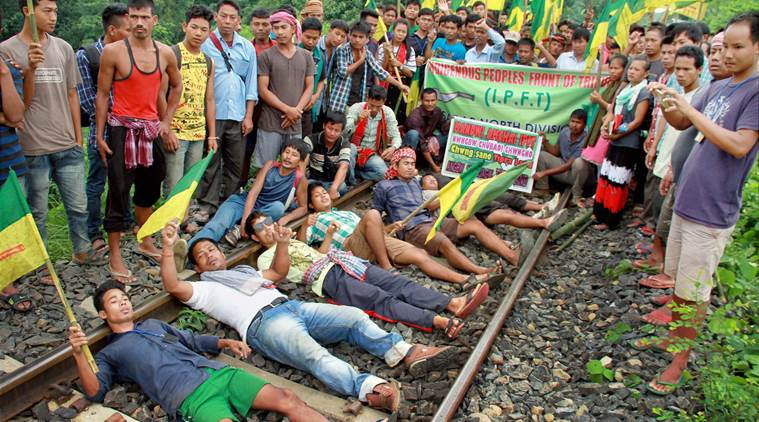The landlocked state of Tripura has hitherto been an oasis of peace in the otherwise restive North East. The state was historically a Kingdom under the Tripuri dynasty and covered a large area stretching into the Comilla district of Bangladesh. At the time of partition of India, the plains of Tripura, known as Tippera district were merged with East Pakistan and the state was confined to the hill districts, corresponding to the present-day Tripura state. The population of Tripura is composed of 2 large communities- the indigenous tribals and the Bengalis. In 1940s, the tribals made up for nearly 50% of the population of the state. Since then, their share in the population has been steadily falling. As per 2001 census, the indigenous Tripuri people made up nearly 30% of the population of the state. For its outward calm, Tripura has at times witnessed an intense ethnic struggle between the indigenous people and the Bengalis, whose numbers swelled in the aftermath of the Pakistani persecution of Bengali Hindus and the subsequent disdain with which Bangladesh has treated its Hindu minorities. The loss in power by the indigenous people fuelled a low running insurgency which sometimes manifested itself through brutalities such as the Mandwi massacre, when nearly 300 Bengali Hindus were massacred in cold blood by Tribal insurgents.
The Congress had been the default party of governance in Tripura until 1978 when the Communists trounced them and took power. The Congress was viewed as a party of Bengali Hindus, while the upstart CPM could boast of solid support from the large tribal population of the state. One of the first actions by the CPM government that came to power in was to work on the creation of an autonomous district council for the Tribals of Tripura. This was also a time, when the first of the insurgent movement took hold in the state. The Tripura National Volunteers (TNV) was one such group that terrorized Bengali Hindus through its strikes, Bazaar Bandhs and bloody riots. The 1980s was a particular bloody period when ethnic riots shook the state, claiming both Bengali and indigenous lives. The Tripura Tribal Autonomous District Council (TTADC) came into effect in 1982. The Communists were evicted from power in 1988, when an opportunist alliance between the now surrendered TNV & Congress swept the state. Far from demanding separation of the Tribal areas, political settlement was reached by increasing the number of ST reserved seats to 20 in the 60-member assembly.
This period saw the rise of more insurgent groups, notably the National Liberation Front of Tripura that was opposed to the CPM & the All Tripura Tiger Force that was pro-CPM. Internecine conflicts between the two groups claimed lives as did their terrorist acts. By the late 90s, the NLFT claimed support from the Baptist Church and gave a call for a ‘Christian Tripura’, where Hindus make up nearly 85% of the population. A low-level insurgency continued to rage. In the early 2000s, the CPM led government pledged to rid Tripura of insurgency, an act that was mostly achieved by strengthening border controls and empowering the state militia. In 2015, the situation had improved to an extent that the dreaded AFSPA was revoked.
The TTADC had historically been under CPM control ever since its inception. In 2000, supported by the NLFT, the Indigenous Peoples Front of Tripura (IPFT), swept the TTADC. Subsequently, an all tribal party alliance by the name of Indigenous Nationalist Party of Tripura was formed with the NLFT’s blessings.
In 2009, the IPFT was reborn to crusade for the cause of the separate state of Tipraland, composed of the Autonomous Tribal Areas. Ever since, the demand for Tipraland has risen again and again in Tripura, especially during the time of elections. In July last year, the IPFT blocked NH8, the state’s lifeline and blocked rail routes. It also staged Naked protests to draw government’s attention on the plight of the indigenous people.
Unlike earlier, when CPM was the unchallenged party of governance in Tripura, BJP is expected to perform strongly in the elections scheduled in February 2018. It seems that as an entry route into a hitherto uncharted political territory, the BJP is using the Tipraland issue to further embarrass the Manik Sarkar led CPM government. Many allege that BJP has given its blessings to the Tipraland state movement, though the party vehemently denies this. Officially, the party has promised to upgrade the TTADC to a formal Autonomous state council as in other parts of the North East. Interestingly, the IPFT has promised BJP support for 2018 elections, indicating that some kind of agreement might be reached between the two.
The creation of new states in our country has more often than not been accompanied by controversy and violence. The separation of Telangana from Andhra being the case in point. Closer to Tripura, bloody protests over Gorkhaland have wrecked the economy of the region and brought misery to millions. Given Tripura’s size and its strategic location bordering Bangladesh, it is a no brainer to see that Tipraland is an unimplementable idea even at the inception state. What is needed perhaps is autonomy, coupled with a strong dose of development. Meddling in complex issues such as these, might bring short term political benefits but will be disastrous for the state in the long run. The BJP should take note of this seriously.
